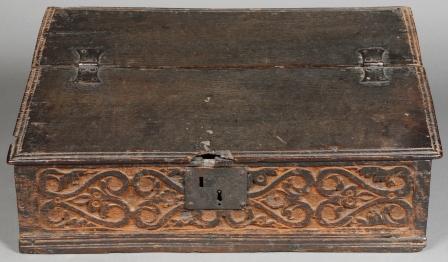Made: In England during the late seventeenth century, by an unknown craftsman
Materials: Oak and iron
To see this object in the Nichols House Museum online collection, search for 1961.64 at http://www.nicholshousemuseum.org/collection.php
Currently On Display at the Nichols House Museum

Adore this piece? Read on to find out how you can own a Nichols House Bible Box!
Three hundred years ago, this dark wooden box would be unrecognizable. Smelling of fresh wood, likely cheerfully painted in the popular brazen colors of the period, and sporting newly wrought iron hardware from the blacksmith, this box would have been an eye-catching but functional piece of decor.[i] During the seventeenth century, a family would have kept small valuables ranging from money and documents to fancy linens inside this box—it was easy to grab in case of a fire. Its slanted top also increased its functionality as a portable podium or desk. During the late nineteenth century, this style of box came to be known as a “Bible box” when people began collecting them as antiques.[ii]
Creation
The English joiner, or carpenter, who made the box, carved the front panel when the wood was freshly split, or green, as it was wet, soft, and easier to carve than if it were dried and aged. Oak is a type of hardwood, and it hardens as it dries.[iii] The wood did not warp during this drying process after it was carved because 1) the wood was of high quality without knots or curves and 2) the wood was cut lengthwise (split) with the grain rather than cut crosswise (sawn) into rounds against the grain. Splitting the wood kept it more stable.[iv] The hand-carved design, if you look closely, is not symmetrical. Naturalistic designs like this one were very popular in England and New England during the period.[v] The box is held together with wooden pegs, and has an interior shelf to keep the contents organized.

Change over time
Over the years, this box has undergone a complete transformation. The box may have lost its original lock when the key was lost, forcing the owner to break it open. The original paint was likely stripped around the turn of the twentieth century when it was popular to refinish old furniture, similar to the repurposing of old furniture today. The box was probably in this condition when Arthur Nichols purchased it for his daughter Rose on February 16, 1912. He specifically recorded in his diary: “Sale at Libbie’s of a consignment of old furniture, clocks, china, crockery and bric-a-brac from England has lasted five afternoons, attracting a large company. I bought a table, two mahogany candle-boxes… [and] an oak bible box was bought for Rose.”[vi]
A Reproduction
Interested in owning your own Bible box? Come to our annual Spring Fête on June 5 at the Boston Athenæum! The talented Oliver Bouchier from Payne-Bouchier, Fine Builders, will reproduce the box as an item in our silent auction.[vii] Bid on your own piece of history at the Spring Fête – for tickets, please visit our website.
By Ashley Jahrling, Assistant to the Director
[i] For a brief discussion of paints and finishes on 17th century English and American furniture, see the New England Antiques Journal article by John Fiske and Lisa Freeman, https://www.antiquesjournal.com/Pages04/Monthly_pages/feb07/twins.html and joiner Peter Follansbee’s blog post on finishes for 17th century reproduction furniture http://pfollansbee.wordpress.com/2010/02/21/what-finish-to-use/.
[ii] According to the Oxford English Dictionary, the term “Bible box” was first recorded in 1904.
[iii] For a breakdown on the difference between hardwood and softwood, visit http://www.diffen.com/difference/Hardwood_vs_Softwood
[iv] For an article chronicling the process of creating furniture in the 17th century style, see Stephanie Stone’s article on Peter Follansbee’s work at: http://www.greenwoodworking.com/PeterFollansbeeSleuthing. Peter Follansbee’s blog, Peter Follansbee, joiner’s notes, can be found at: http://pfollansbee.wordpress.com/.
[v] For a discussion of seventeenth century furniture styles, see The New England Antiques Journal article by John Fiske and Lisa Freeman, https://www.antiquesjournal.com/Pages04/Monthly_pages/feb07/twins.html. See also the Metropolitan Museum of Art’s Heilbrunn Timeline of Art History on American Furniture, 1620-1730: The Seventeenth Century and William and Mary Styles: http://www.metmuseum.org/toah/hd/will/hd_will.htm.
[vi] Arthur Howard Nichols Papers, Massachusetts Historical Society.
[vii] For more information about Payne-Bouchier, Fine Builders, visit their website http://www.paynebouchier.com/


You must be logged in to post a comment.